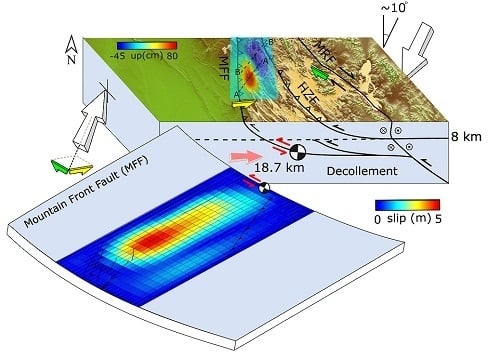Coseismic Deformation Field of the Mw 7.3 12 November 2017 Sarpol-e Zahab (Iran) Earthquake: A Decoupling Horizon in the Northern Zagros Mountains Inferred from InSAR Observations
Abstract
:1. Introduction
2. Data Processing
2.1. Across-Track Interferometry
2.2. Offset Tracking
3. Fault Geometry and Slip Distribution
4. Discussion
4.1. Comparison of the Slip Models
4.2. Geodynamics Implication
4.3. Field Survey
4.3.1. Mela-Kabod Landslide
4.3.2. Rockslides
4.3.3. Secondary Faulting
5. Conclusions
Supplementary Materials
Author Contributions
Funding
Acknowledgments
Conflicts of Interest
References
- Jackson, J.; Fitch, T. Basement faulting and the focal depths of the larger earthquakes in the Zagros mountains (Iran). Geophys. J. R. Astron. Soc. 1981. [Google Scholar] [CrossRef]
- Talebian, M.; Jackson, J. A reappraisal of earthquake focal mechanisms and active shortening in the Zagros mountains of Iran. Geophys. J. Int. 2004. [Google Scholar] [CrossRef]
- Angster, S.; Fielding, E.J.; Wesnousky, S.; Pierce, I.; Chamlagain, D.; Gautam, D.; Upreti, B.N.; Kumahara, Y.; Nakata, T. Field Reconnaissance after the 25 April 2015 M 7.8 Gorkha Earthquake. Seismol. Res. Lett. 2015. [Google Scholar] [CrossRef]
- Biggs, J.; Bergman, E.; Emmerson, B.; Funning, G.J.; Jackson, J.; Parsons, B.; Wright, T.J. Fault identification for buried strike-slip earthquakes using InSAR: The 1994 and 2004 Al Hoceima, Morocco earthquakes. Geophys. J. Int. 2006. [Google Scholar] [CrossRef]
- Bürgmann, R.; Hilley, G.; Ferretti, A.; Novali, F. Resolving vertical tectonics in the San Francisco Bay Area from permanent scatterer InSAR and GPS analysis. Geology 2006. [Google Scholar] [CrossRef]
- Grandin, R.; Doin, M.P.; Bollinger, L.; Pinel-Puysségur, B.; Ducret, G.; Jolivet, R.; Sapkota, S.N. Long-term growth of the Himalaya inferred from interseismic InSAR measurement. Geology 2012. [Google Scholar] [CrossRef]
- Nissen, E.; Ghorashi, M.; Jackson, J.; Parsons, B.; Talebian, M. The 2005 Qeshm Island earthquake (Iran)—A link between buried reverse faulting and surface folding in the Zagros Simply Folded Belt? Geophys. J. Int. 2007. [Google Scholar] [CrossRef]
- Motagh, M.; Schurr, B.; Anderssohn, J.; Cailleau, B.; Walter, T.R.; Wang, R.; Villotte, J.P. Subduction earthquake deformation associated with 14 November 2007, Mw 7.8 Tocopilla earthquake in Chile: Results from InSAR and aftershocks. Tectonophysics 2010. [Google Scholar] [CrossRef]
- Moreno, M.; Li, S.; Melnick, D.; Bedford, J.R.; Baez, J.C.; Motagh, M.; Metzger, S.; Vajedian, S.; Sippl, C.; Gutknecht, B.D.; et al. Chilean megathrust earthquake recurrence linked to frictional contrast at depth. Nat. Geosci. 2018. [Google Scholar] [CrossRef]
- Motagh, M.; Beavan, J.; Fielding, E.J.; Haghshenas, M. Postseismic ground deformation following the September 2010 Darfield, New Zealand, earthquake from terraSAR-X, COSMO-SkyMed, and ALOS InSAR. IEEE Geosci. Remote Sens. Lett. 2014. [Google Scholar] [CrossRef]
- Vernant, P.; Nilforoushan, F.; Hatzfeld, D.; Abbassi, M.R.; Vigny, C.; Masson, F.; Nankali, H.; Martinod, J.; Ashtiani, A.; Bayer, R.; et al. Present-day crustal deformation and plate kinematics in the Middle East constrained by GPS measurements in Iran and northern Oman. Geophys. J. Int. 2004. [Google Scholar] [CrossRef]
- Berberian, M. Master “blind” thrust faults hidden under the Zagros folds: Active basement tectonics and surface morphotectonics. Tectonophysics 1995. [Google Scholar] [CrossRef]
- Authemayou, C.; Chardon, D.; Bellier, O.; Malekzadeh, Z.; Shabanian, E.; Abbassi, M.R. Late Cenozoic partitioning of oblique plate convergence in the Zagros fold-and-thrust belt (Iran). Tectonics 2006. [Google Scholar] [CrossRef]
- Bowman, D.; King, G.; Tapponnier, P. Slip partitioning by elastoplastic propagation of oblique slip at depth. Science 2003. [Google Scholar] [CrossRef] [PubMed]
- Motaghi, K.; Shabanian, E.; Kalvandi, F. Underplating along the northern portion of the Zagros suture zone, Iran. Geophys. J. Int. 2017. [Google Scholar] [CrossRef]
- Tatar, M.; Hatzfeld, D.; Ghafory-Ashtiany, M. Tectonics of the Central Zagros (Iran) deduced from microearthquake seismicity. Geophys. J. Int. 2004. [Google Scholar] [CrossRef]
- Yaminifard, F.; Sedghi, M.H.; Gholamzadeh, A.; Tatar, M.; Hessami, K. Active faulting of the southeastern-most Zagros (Iran): Microearthquake seismicity and crustal structure. J. Geodyn. 2012. [Google Scholar] [CrossRef]
- Jackson, J.A. Reactivation of basement faults and crustal shortening in orogenic belts. Nature 1980. [Google Scholar] [CrossRef]
- Roustaei, M.; Nissen, E.; Abbassi, M.; Gholamzadeh, A.; Ghorashi, M.; Tatar, M.; Yamini-Fard, F.; Bergman, E.; Jackson, J.; Parsons, B. The 2006 March 25 Fin earthquakes (Iran)—Insights into the vertical extents of faulting in the Zagros Simply Folded Belt. Geophys. J. Int. 2010. [Google Scholar] [CrossRef]
- Nissen, E.; Tatar, M.; Jackson, J.A.; Allen, M.B. New views on earthquake faulting in the Zagros fold-and-thrust belt of Iran. Geophys. J. Int. 2011. [Google Scholar] [CrossRef] [Green Version]
- Motagh, M.; Bahroudi, A.; Haghighi, M.H.; Samsonov, S.; Fielding, E.; Wetzel, H.-U. The 18 August 2014 Mw 6.2 Mormori, Iran, Earthquake: A Thin-Skinned Faulting in the Zagros Mountain Inferred from InSAR Measurements. Seismol. Res. Lett. 2015, 86, 775–782. [Google Scholar] [CrossRef] [Green Version]
- Copley, A.; Karasozen, E.; Oveisi, B.; Elliott, J.R.; Samsonov, S.; Nissen, E. Seismogenic faulting of the sedimentary sequence and laterally variable material properties in the Zagros Mountains (Iran) revealed by the August 2014 murmuri (E. Dehloran) earthquake sequence. Geophys. J. Int. 2015. [Google Scholar] [CrossRef]
- Ambraseys, N.N.; Melville, C.P. A History of Persian Earthquakes; Cambridge Earth Science Series; Cambridge University Press: Cambridge, UK, 2005; ISBN 1107645794. [Google Scholar]
- Tavani, S.; Parente, M.; Puzone, F.; Corradetti, A.; Gharabeigli, G.; Valinejad, M.; Morsalnejad, D.; Mazzoli, S. The seismogenic fault system of the 2017 Mw7.3 Iran-Iraq earthquake: Constraints from surface and subsurface data, cross-section balancing, and restoration. Solid Earth 2018. [Google Scholar] [CrossRef]
- Barnhart, W.D.; Brengman, C.M.J.; Li, S.; Peterson, K.E. Ramp-flat basement structures of the Zagros Mountains inferred from co-seismic slip and afterslip of the 2017 Mw7.3 Darbandikhan, Iran/Iraq earthquake. Earth Planet. Sci. Lett. 2018. [Google Scholar] [CrossRef]
- Feng, W.; Samsonov, S.; Almeida, R.; Yassaghi, A.; Li, J.; Qiu, Q.; Li, P.; Zheng, W. Geodetic Constraints of the 2017 Mw7.3 Sarpol Zahab, Iran Earthquake, and Its Implications on the Structure and Mechanics of the Northwest Zagros Thrust-Fold Belt. Geophys. Res. Lett. 2018. [Google Scholar] [CrossRef]
- Vajedian, S.; Motagh, M. Coseismic Displacement Analysis of the 12 17 MW 7.3 Sarpol-e Zahab (IRAN) Earthquake from SAR Interferometry, Burst Overlap Interferometry and Offset Tracking. In Proceedings of the ISPRS TC III Mid-term Symposium Developments, Technologies and Applications in Remote Sensing, Beijing, China, 7–10 May 2018. [Google Scholar]
- Washaya, P.; Balz, T. SAR COHERENCE change detection of urban areas affected by disasters using Sentinel-1 imagery. ISPRS 2018, XLII-3, 1857–1861. [Google Scholar] [CrossRef]
- Karimzadeh, S.; Matsuoka, M.; Miyajima, M.; Adriano, B.; Fallahi, A.; Karashi, J. Sequential SAR coherence method for the monitoring of buildings in Sarpole-Zahab, Iran. Remote Sens. 2018. [Google Scholar] [CrossRef]
- Olen, S.; Bookhagen, B. Mapping damage-affected areas after natural hazard events using Sentinel-1 coherence time series. Remote Sens. 2018. [Google Scholar] [CrossRef]
- Miyamjima, M.; Fallahi, A.; Ikemoto, T.; Samaei, M.; Karimzadeh, S.; Setiawan, H.; Talebi, F.; Karashi, J. Site Investigation of the Sarpole-Zahab Earthquake, Mw 7.3 in SW Iran of November 12, 2017. JSCE J. Disaster FactSheets 2018. [Google Scholar]
- Wegmüller, U.; Werner, C. Gamma SAR processor and interferometry software. In Proceedings of the 3rd ERS Symposium, Florence, Italy, 14–21 March 1997. [Google Scholar]
- Prats-Iraola, P.; Scheiber, R.; Marotti, L.; Wollstadt, S.; Reigber, A. TOPS interferometry with terraSAR-X. IEEE Trans. Geosci. Remote Sens. 2012. [Google Scholar] [CrossRef] [Green Version]
- Farr, T.G.; Kobrick, M. Shuttle radar topography mission produces a wealth of data. Eos 2000. [Google Scholar] [CrossRef]
- Wegmüller, U.; Werner, C.; Wiesmann, A. ALOS-2 PALSAR-2 support in GAMMA Software; Gamma Remote Sensing: Gümligen, Switzerland, 2014. [Google Scholar]
- Costantini, M. A novel phase unwrapping method based on network programming. Geosci. Remote Sens. IEEE Trans. 1998. [Google Scholar] [CrossRef]
- Wang, H.; Liu-Zeng, J.; Ng, A.H.-M.; Ge, L.; Javed, F.; Long, F.; Aoudia, A.; Feng, J.; Shao, Z. Sentinel-1 observations of the 2016 Menyuan earthquake: A buried reverse event linked to the left-lateral Haiyuan fault. Int. J. Appl. Earth Obs. Geoinf. 2017. [Google Scholar] [CrossRef]
- Fattahi, H.; Simons, M.; Agram, P. InSAR Time-Series Estimation of the Ionospheric Phase Delay: An Extension of the Split Range-Spectrum Technique. IEEE Trans. Geosci. Remote Sens. 2017. [Google Scholar] [CrossRef]
- Wei, M.; Sandwell, D.T. Decorrelation of L-band and C-band interferometry over vegetated areas in California. IEEE Trans. Geosci. Remote Sens. 2010. [Google Scholar] [CrossRef]
- Wright, T.J. Toward mapping surface deformation in three dimensions using InSAR. Geophys. Res. Lett. 2004. [Google Scholar] [CrossRef]
- Grandin, R.; Klein, E.; Métois, M.; Vigny, C. Three-dimensional displacement field of the 2015 Mw8.3 Illapel earthquake (Chile) from across- and along-track Sentinel-1 TOPS interferometry. Geophys. Res. Lett. 2016. [Google Scholar] [CrossRef]
- Pathier, E.; Fielding, E.J.; Wright, T.J.; Walker, R.; Parsons, B.E.; Hensley, S. Displacement field and slip distribution of the 2005 Kashmir earthquake from SAR imagery. Geophys. Res. Lett. 2006. [Google Scholar] [CrossRef]
- Wang, T.; Shi, Q.; Nikkhoo, M.; Wei, S.; Barbot, S.; Dreger, D.; Bürgmann, R.; Motagh, M.; Chen, Q.F. The rise, collapse, and compaction of Mt. Mantap from the 3 September 2017 North Korean nuclear test. Science 2018. [Google Scholar] [CrossRef] [PubMed]
- Okada, Y. Surface deformation due to shear and tensile faults in a half-space Okada, Y Bull Seismol Soc AmV75, N4, Aug 1985, P1135–1154. Int. J. Rock Mech. Min. Sci. Geomech. Abstr. 1985. [Google Scholar] [CrossRef]
- Bagnardi, M.; Hooper, A. Inversion of Surface Deformation Data for Rapid Estimates of Source Parameters and Uncertainties: A Bayesian Approach. Geochem. Geophys. Geosyst. 2018. [Google Scholar] [CrossRef]
- Hastings, W.K. Monte carlo sampling methods using Markov chains and their applications. Biometrika 1970. [Google Scholar] [CrossRef]
- Lohman, R.B.; Simons, M. Some thoughts on the use of InSAR data to constrain models of surface deformation: Noise structure and data downsampling. Geochem. Geophys. Geosyst. 2005. [Google Scholar] [CrossRef]
- Harris, R.A.; Segall, P. Detection of a locked zone at depth on the Parkfield, California, segment of the San Andreas fault (USA). J. Geophys. Res. 1987. [Google Scholar] [CrossRef]
- Hansen, P.C.; O’Leary, D.P. The Use of the L-Curve in the Regularization of Discrete Ill-Posed Problems. SIAM J. Sci. Comput. 1993. [Google Scholar] [CrossRef]
- USGS U. S. Geological Survey (12 November 2017): M7.3—30km S of Halabjar, Iraq. Available online: https://earthquake.usgs.gov/earthquakes/eventpage/us2000bmcg#impact (accessed on 1 October 2018).
- Elliott, J.R.; Parsons, B.; Jackson, J.A.; Shan, X.; Sloan, R.A.; Walker, R.T. Depth segmentation of the seismogenic continental crust: The 2008 and 2009 Qaidam earthquakes. Geophys. Res. Lett. 2011. [Google Scholar] [CrossRef]
- Zhdanov, M.S. Inverse Theory and Applications in Geophysics; Elsevier: New York, NY, USA, 2015; ISBN 9780444626745. [Google Scholar]
- Aki, K. Asperities, barriers, characteristic earthquakes and strong motion prediction (Japan). J. Geophys. Res. 1984. [Google Scholar] [CrossRef]
- Julià, J.; Ammon, C.J.; Herrmann, R.B.; Correig, A.M. Joint inversion of receiver function and surface wave dispersion observations. Geophys. J. Int. 2000. [Google Scholar] [CrossRef]
- Jiang, M.; Chen, L. Fine Crustal Structure in the Northwestern Iranian Plateau Revealed by Ambient Noise Tomography. In Proceedings of the EGU General Assembly Conference Abstracts, Vienna Austria, 17–22 April 2016. [Google Scholar]
- Motaghi, K.; Tatar, M.; Priestley, K.; Romanelli, F.; Doglioni, C.; Panza, G.F. The deep structure of the Iranian Plateau. Gondwana Res. 2015. [Google Scholar] [CrossRef] [Green Version]
- Kennett, B.L.N.; Engdahl, E.R.; Buland, R. Constraints on seismic velocities in the Earth from traveltimes. Geophys. J. Int. 1995. [Google Scholar] [CrossRef]
- Hatzfeld, D.; Tatar, M.; Priestley, K.; Ghafory-Ashtiany, M. Seismological constraints on the crustal structure beneath the Zagros Mountain belt (Iran). Geophys. J. Int. 2003. [Google Scholar] [CrossRef]
- Alavi, M. Structures of the Zagros fold-thrust belt in Iran. Am. J. Sci. 2007. [Google Scholar] [CrossRef]
- Blanc, E.J.-P.; Allen, M.B.; Inger, S.; Hassani, H. Structural styles in the Zagros Simple Folded Zone, Iran. J. Geol. Soc. London 2003. [Google Scholar] [CrossRef]
- Emami, H.; Vergés, J.; Nalpas, T.; Gillespie, P.; Sharp, I.; Karpuz, R.; Blanc, E.P.; Goodarzi, M.G.H. Structure of the Mountain Front Flexure along the Anaran anticline in the Pusht-e Kuh Arc (NW Zagros, Iran): Insights from sand box models. Geol. Soc. London, Spec. Publ. 2010. [Google Scholar] [CrossRef]
- McQuarrie, N. Crustal scale geometry of the Zagros fold-thrust belt, Iran. J. Struct. Geol. 2004. [Google Scholar] [CrossRef]
- Jackson, M.P.A.; Talbot, C.J. External shapes, strain rates, and dynamics of salt structures. Geol. Soc. Am. Bull. 1986. [Google Scholar] [CrossRef]
- Talbot, C.J.; Alavi, M. The past of a future syntaxis across the Zagros. Geol. Soc. Lond. Spec. Publ. 1996. [Google Scholar] [CrossRef]
- Vergés, J.; Saura, E.; Casciello, E.; Fernàndez, M.; Villaseñor, A.; Jiménez-Munt, I.; García-Castellanos, D. Crustal-scale cross-sections across the NW Zagros belt: Implications for the Arabian margin reconstruction. Geol. Mag. 2011. [Google Scholar] [CrossRef]
- Hessami, K.; Jamali, F.; Tabassi, H. Major Active Faults of Iran; International Institute of Earthquake Engineering and Seismology (IIEES): Tehran, Iran, 2003. [Google Scholar]
- Tatar, M.; Hatzfeld, D.; Martinod, J.; Walpersdorf, A.; Ghafori-Ashtiany, M.; Chéry, J. The present-day deformation of the central Zagros from GPS measurements. Geophys. Res. Lett. 2002. [Google Scholar] [CrossRef]
- Wasowski, J.; Keefer, D.K.; Lee, C.T. Toward the next generation of research on earthquake-induced landslides: Current issues and future challenges. Eng. Geol. 2011, 122, 1–8. [Google Scholar] [CrossRef]
- Huang, M.H.; Tung, H.; Fielding, E.J.; Huang, H.H.; Liang, C.; Huang, C.; Hu, J.C. Multiple fault slip triggered above the 2016 Mw6.4 MeiNong earthquake in Taiwan. Geophys. Res. Lett. 2016. [Google Scholar] [CrossRef]
- Huang, M.H.; Fielding, E.J.; Liang, C.; Milillo, P.; Bekaert, D.; Dreger, D.; Salzer, J. Coseismic deformation and triggered landslides of the 2016 Mw6.2 Amatrice earthquake in Italy. Geophys. Res. Lett. 2017. [Google Scholar] [CrossRef]
- Wright, T.; Fielding, E.; Parsons, B. Triggered slip : Observations of the 17 August 1999 Izmit (Turkey) earthquake using radar interferometry. Geophys. Res. Lett. 2001. [Google Scholar] [CrossRef]
- Kramer, S.L. Geotechnical Earthquake Engineering; Pearson Education: London, UK, 1996; ISBN 0133749436. [Google Scholar]
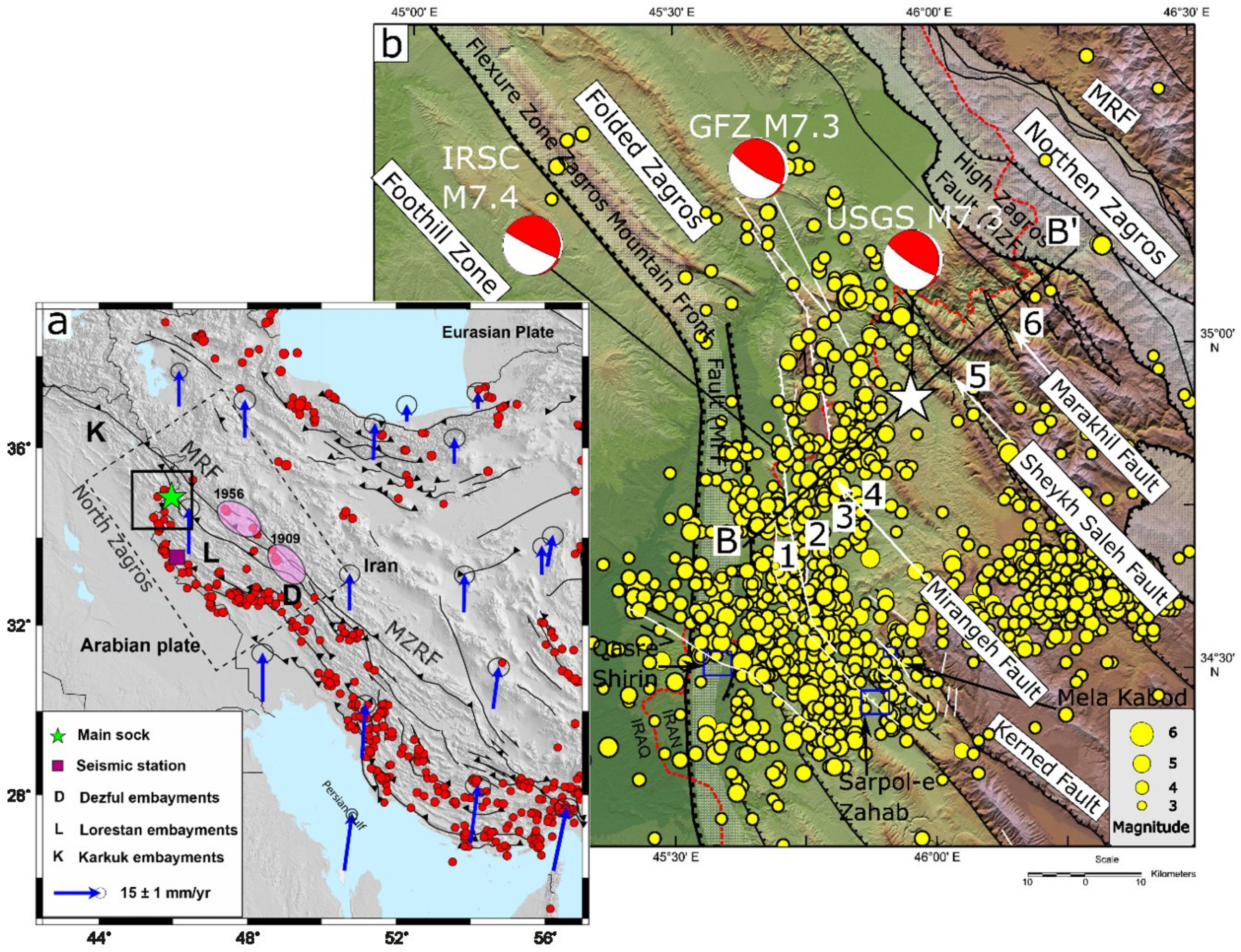
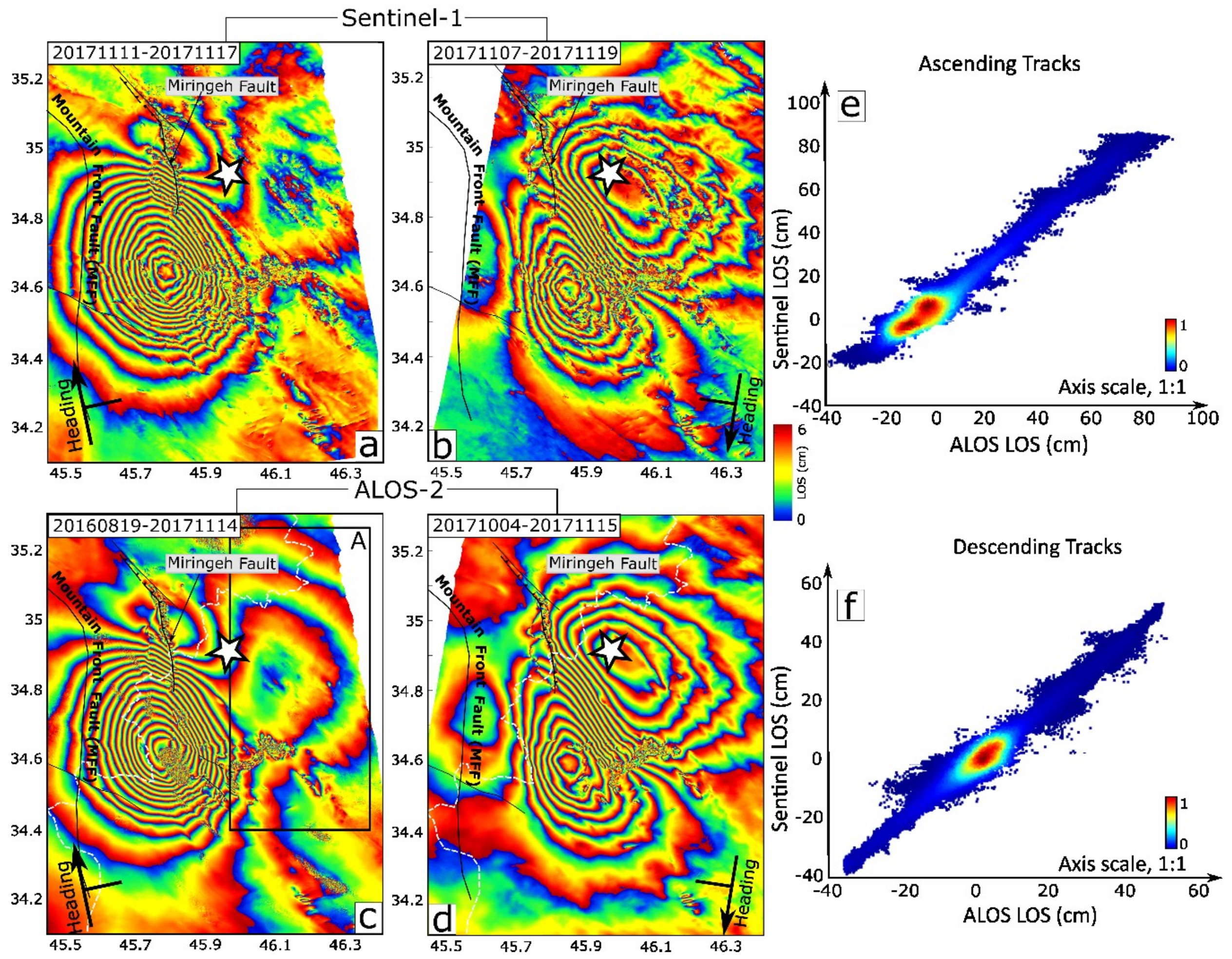
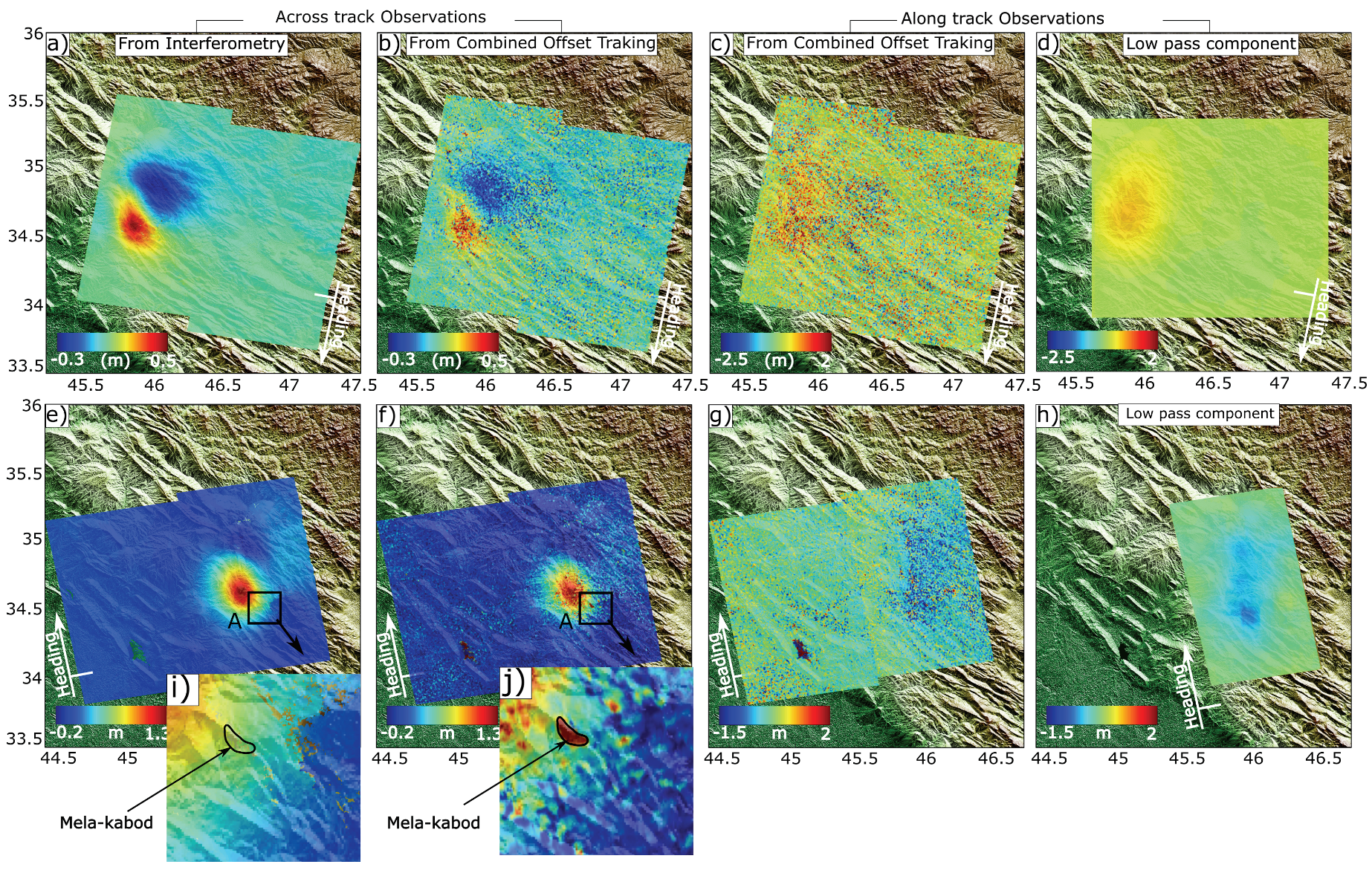
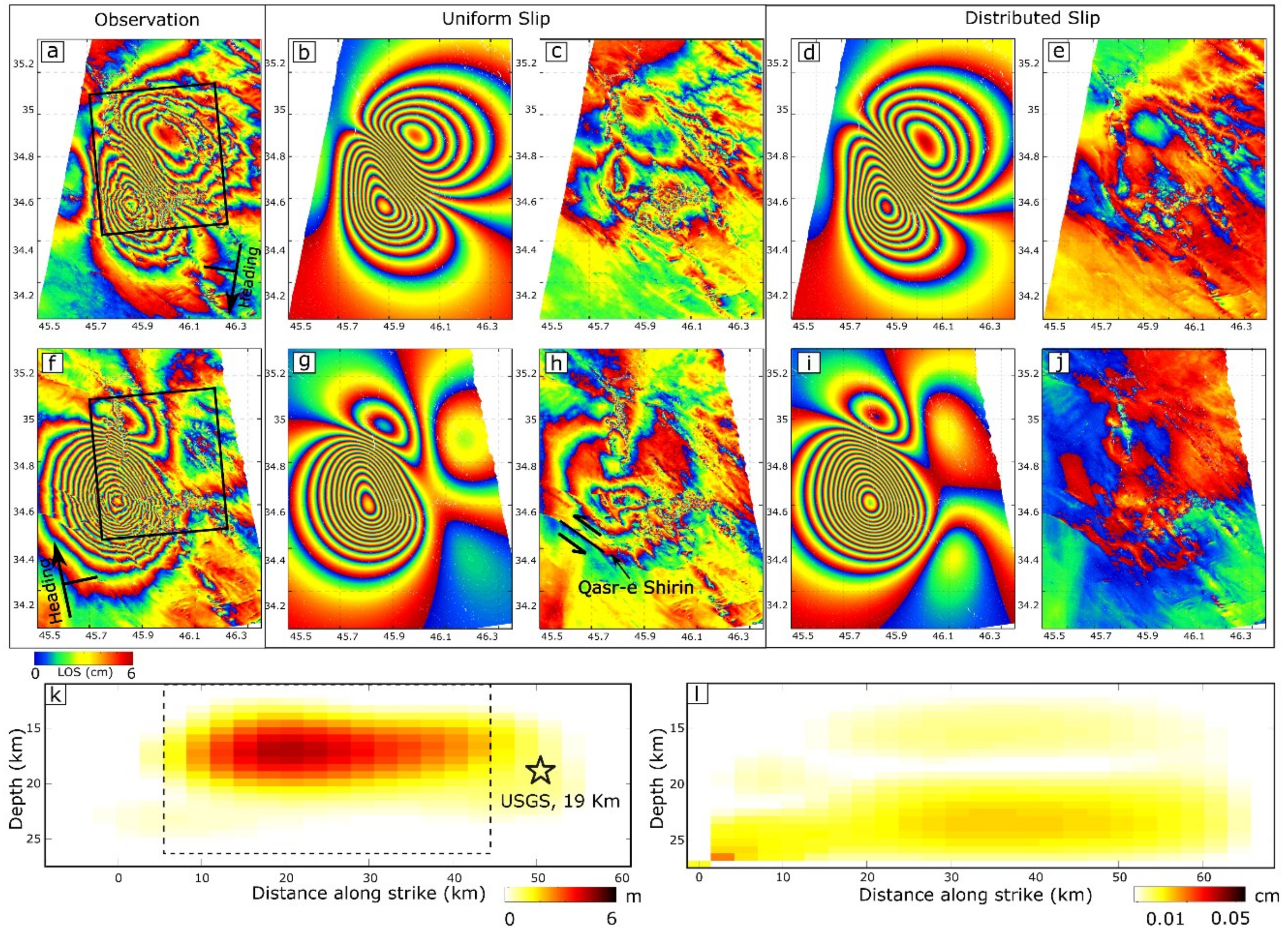
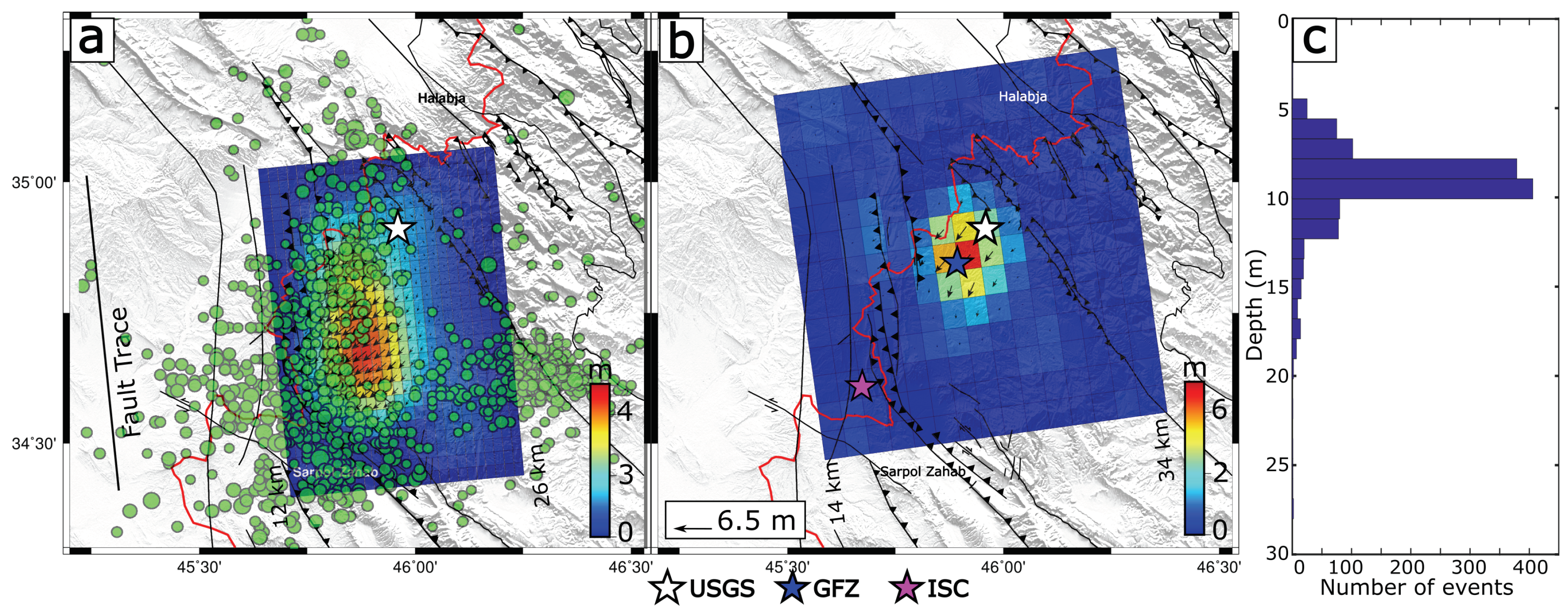

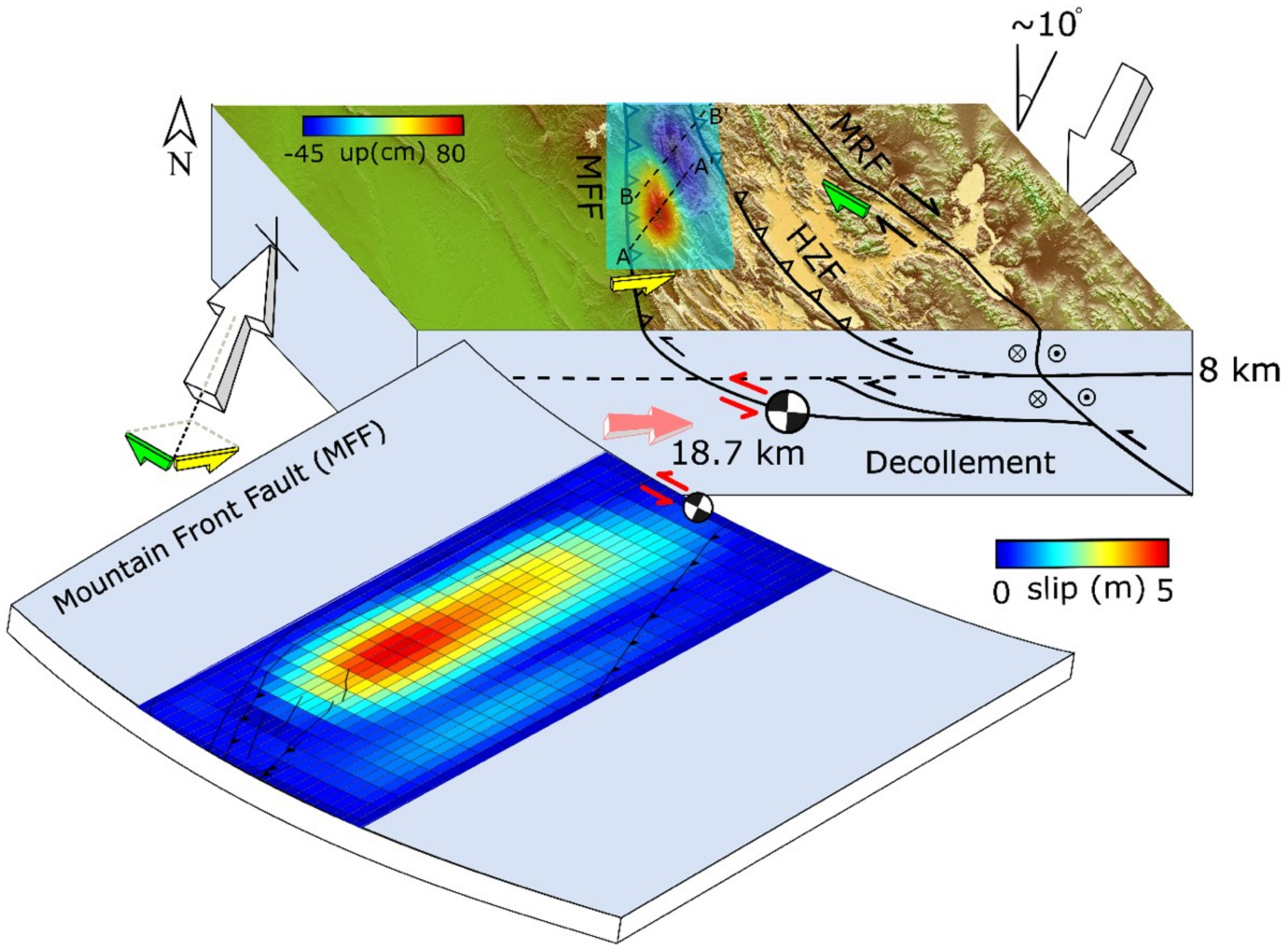
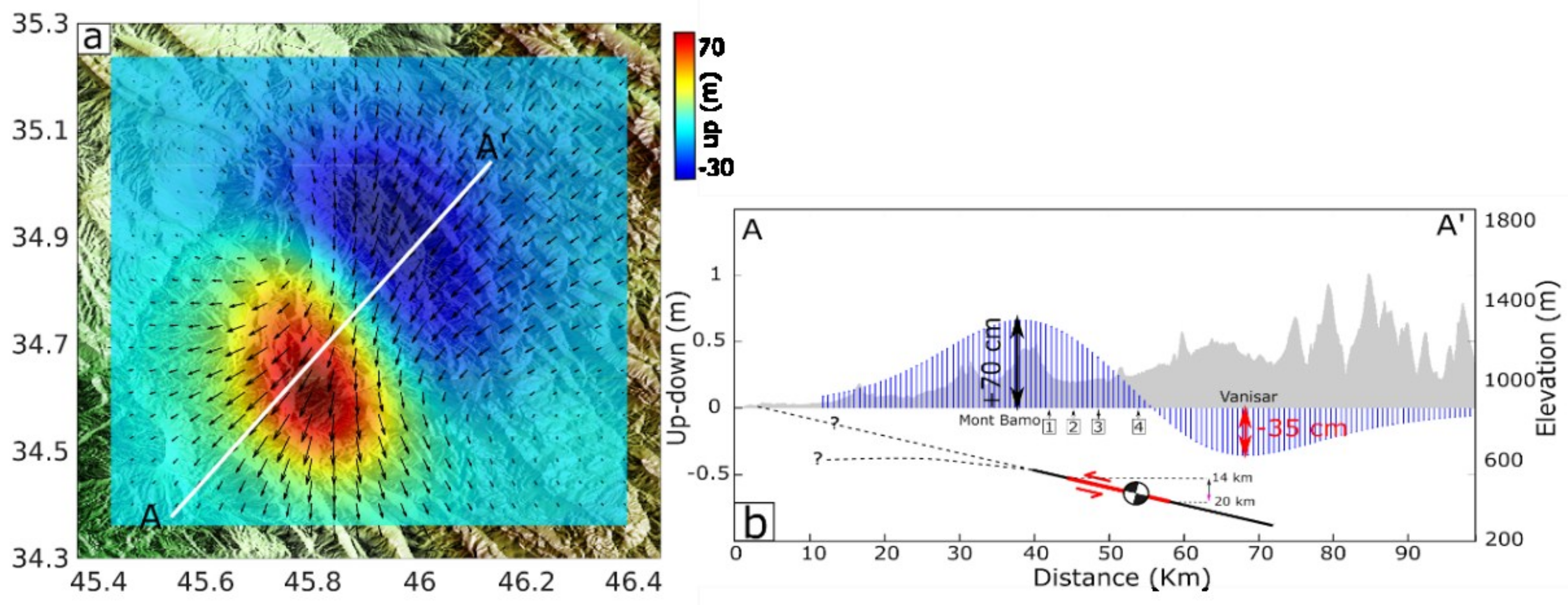
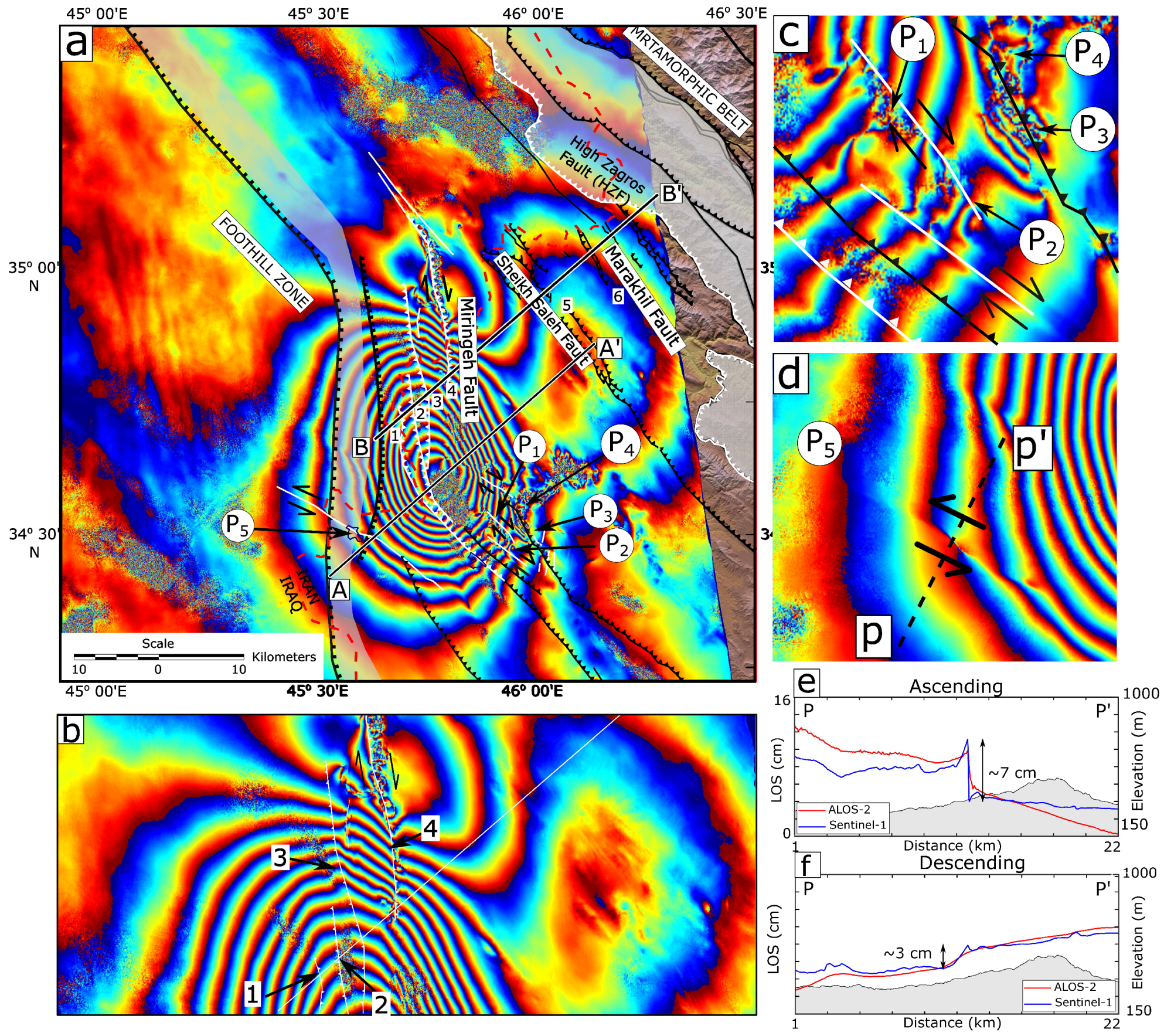
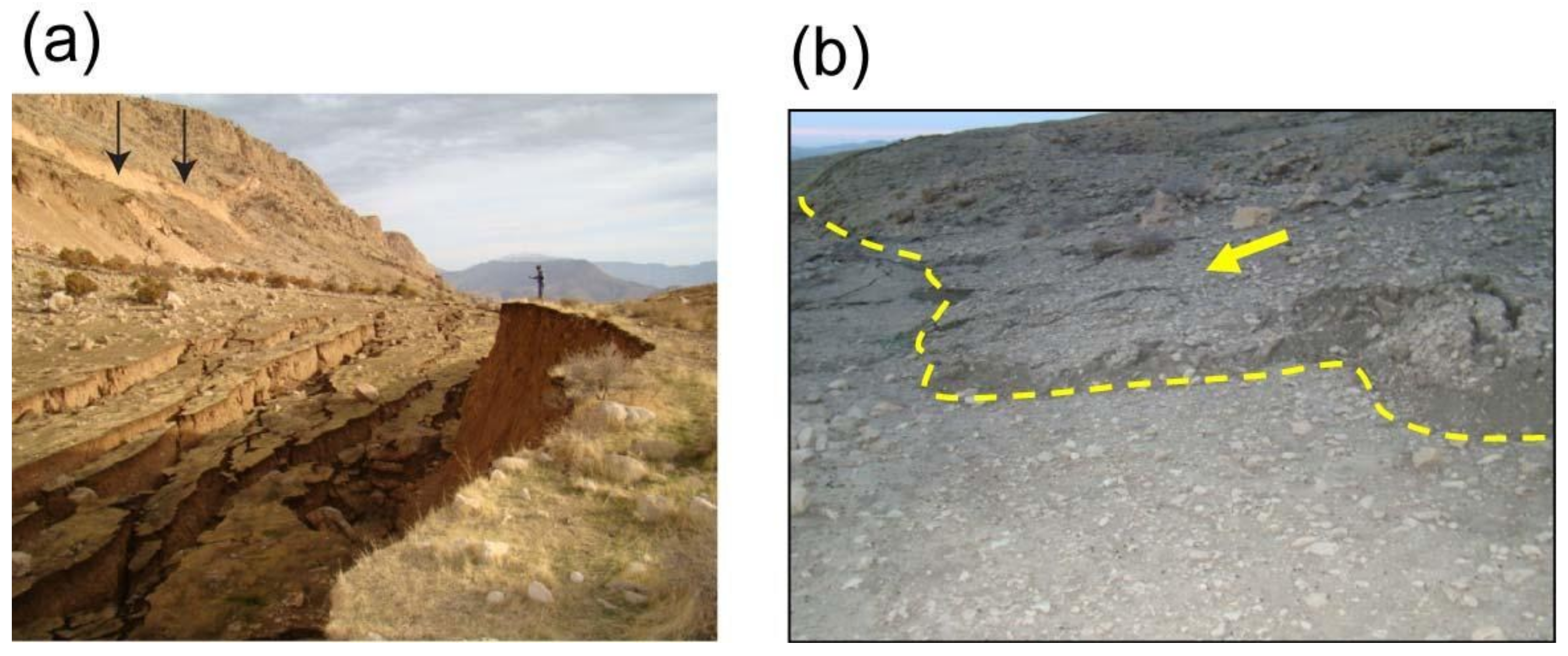
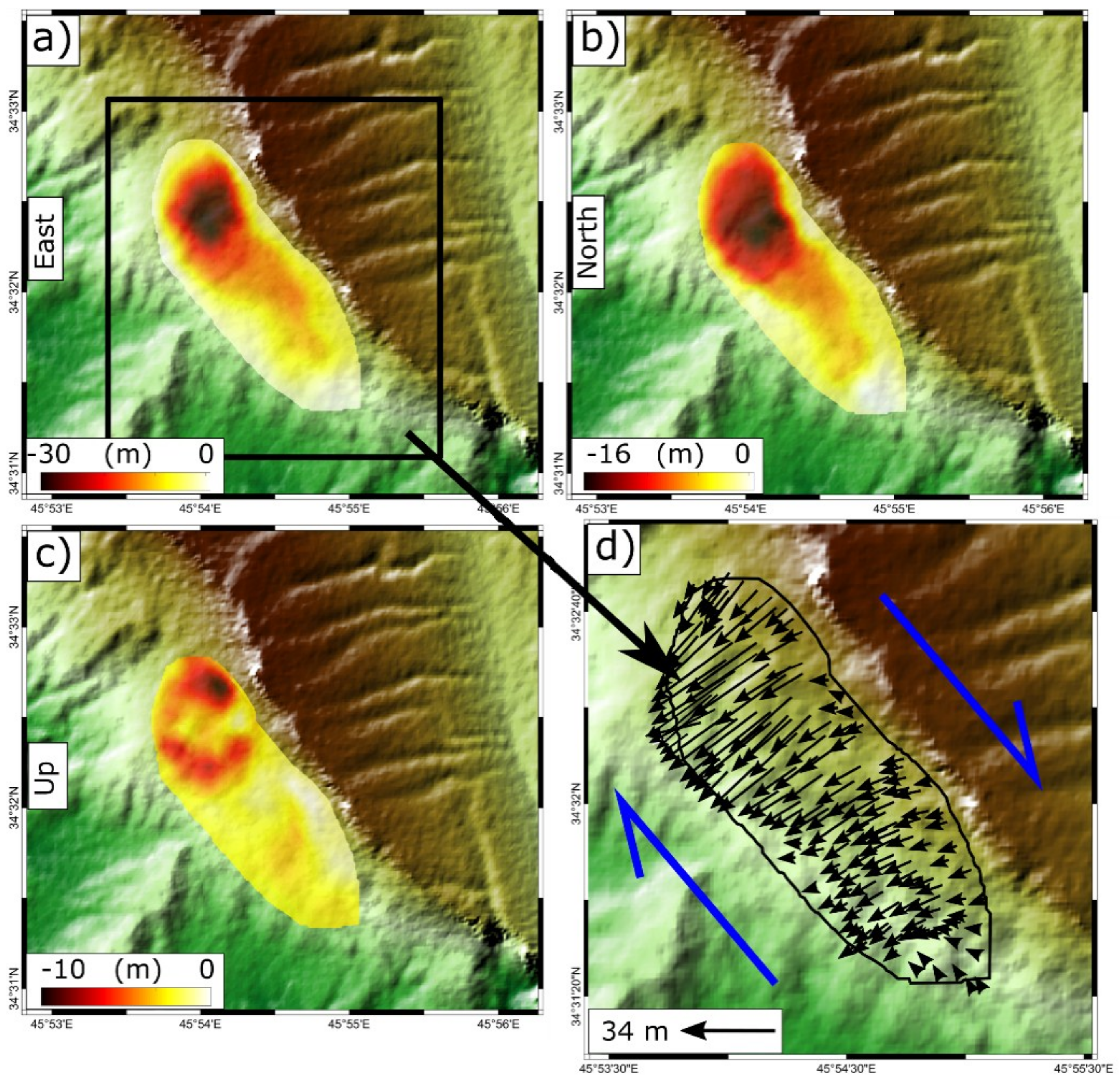
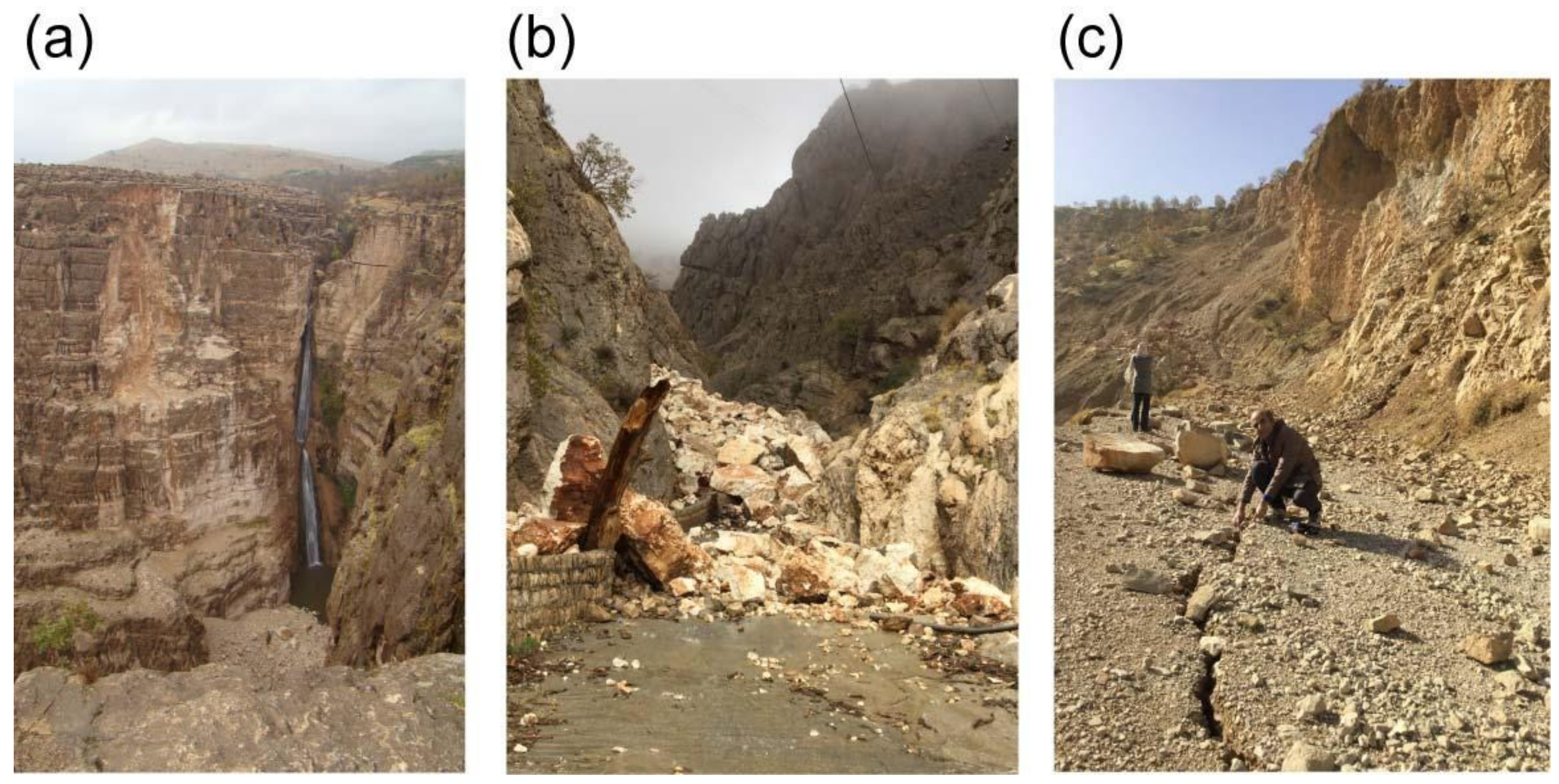
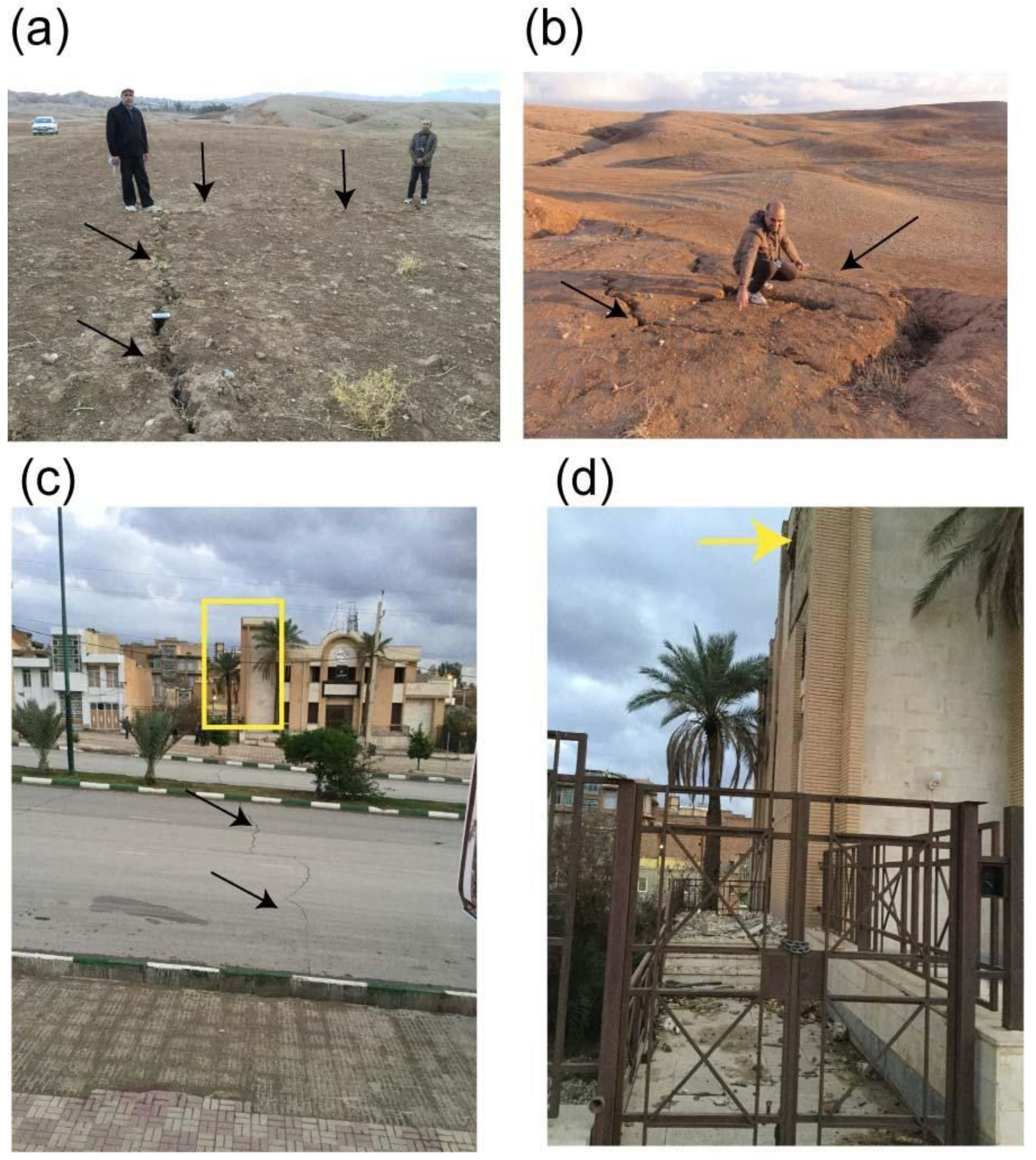
© 2018 by the authors. Licensee MDPI, Basel, Switzerland. This article is an open access article distributed under the terms and conditions of the Creative Commons Attribution (CC BY) license (http://creativecommons.org/licenses/by/4.0/).
Share and Cite
Vajedian, S.; Motagh, M.; Mousavi, Z.; Motaghi, K.; Fielding, E.J.; Akbari, B.; Wetzel, H.-U.; Darabi, A. Coseismic Deformation Field of the Mw 7.3 12 November 2017 Sarpol-e Zahab (Iran) Earthquake: A Decoupling Horizon in the Northern Zagros Mountains Inferred from InSAR Observations. Remote Sens. 2018, 10, 1589. https://doi.org/10.3390/rs10101589
Vajedian S, Motagh M, Mousavi Z, Motaghi K, Fielding EJ, Akbari B, Wetzel H-U, Darabi A. Coseismic Deformation Field of the Mw 7.3 12 November 2017 Sarpol-e Zahab (Iran) Earthquake: A Decoupling Horizon in the Northern Zagros Mountains Inferred from InSAR Observations. Remote Sensing. 2018; 10(10):1589. https://doi.org/10.3390/rs10101589
Chicago/Turabian StyleVajedian, Sanaz, Mahdi Motagh, Zahra Mousavi, Khalil Motaghi, Eric. J. Fielding, Bahman Akbari, Hans-Ulrich Wetzel, and Aliakbar Darabi. 2018. "Coseismic Deformation Field of the Mw 7.3 12 November 2017 Sarpol-e Zahab (Iran) Earthquake: A Decoupling Horizon in the Northern Zagros Mountains Inferred from InSAR Observations" Remote Sensing 10, no. 10: 1589. https://doi.org/10.3390/rs10101589





